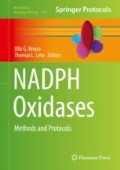Abstract
Hydroethidine is a fluorogenic probe that in the presence of the superoxide radical anion is oxidized to a red fluorescent product, 2-hydroxyethidium. In cells, hydroethidine is also oxidized to other products, including red fluorescent ethidium. Thus, selective monitoring of 2-hydroxyethidium is required for specific detection of the superoxide radical anion. Here, we provide protocols for HPLC- and LC-MS-based quantitation of 2-hydroxyethidium, among other oxidation products. Also, a protocol for continuous sampling for real-time monitoring of superoxide production using rapid HPLC measurements of 2-hydroxyethidium is described.
Access this chapter
Tax calculation will be finalised at checkout
Purchases are for personal use only
References
Lambeth JD (2004) NOX enzymes and the biology of reactive oxygen. Nat Rev Immunol 4:181–189
Winterbourn CC (2008) Reconciling the chemistry and biology of reactive oxygen species. Nat Chem Biol 4:278–286
Bedard K, Krause KH (2007) The NOX family of ROS-generating NADPH oxidases: physiology and pathophysiology. Physiol Rev 87:245–313
Maghzal GJ, Krause KH, Stocker R, Jaquet V (2012) Detection of reactive oxygen species derived from the family of NOX NADPH oxidases. Free Radic Biol Med 53:1903–1918
Wardman P (2007) Fluorescent and luminescent probes for measurement of oxidative and nitrosative species in cells and tissues: progress, pitfalls, and prospects. Free Radic Biol Med 43:995–1022
Zielonka J, Kalyanaraman B (2018) Small-molecule luminescent probes for the detection of cellular oxidizing and nitrating species. Free Radic Biol Med 128:3–22. https://doi.org/10.1016/j.freeradbiomed.2018.03.032
Zielonka J, Lambeth JD, Kalyanaraman B (2013) On the use of L-012, a luminol-based chemiluminescent probe, for detecting superoxide and identifying inhibitors of NADPH oxidase: a reevaluation. Free Radic Biol Med 65:1310–1314
Zielonka J, Kalyanaraman B (2010) Hydroethidine- and MitoSOX-derived red fluorescence is not a reliable indicator of intracellular superoxide formation: another inconvenient truth. Free Radic Biol Med 48:983–1001
Fernandes DC, Goncalves RC, Laurindo FR (2017) Measurement of superoxide production and NADPH oxidase activity by HPLC analysis of dihydroethidium oxidation. Methods Mol Biol (Clifton, NJ) 1527:233–249
Laurindo FR, Fernandes DC, Santos CX (2008) Assessment of superoxide production and NADPH oxidase activity by HPLC analysis of dihydroethidium oxidation products. Methods Enzymol 441:237–260
Fernandes DC, Wosniak J Jr, Pescatore LA, Bertoline MA, Liberman M, Laurindo FR, Santos CX (2007) Analysis of DHE-derived oxidation products by HPLC in the assessment of superoxide production and NADPH oxidase activity in vascular systems. Am J Physiol Cell Physiol 292:C413–C422
Zielonka J et al (2017) Recent developments in the probes and assays for measurement of the activity of NADPH oxidases. Cell Biochem Biophys 75:335–349
Zielonka J et al (2016) Mitigation of NADPH oxidase 2 activity as a strategy to inhibit peroxynitrite formation. J Biol Chem 291:7029–7044
Zielonka J et al (2014) High-throughput assays for superoxide and hydrogen peroxide design of a screening workflow to identify inhibitors of NADPH oxidases. J Biol Chem 289:16176–16189
Zielonka J et al (2012) Global profiling of reactive oxygen and nitrogen species in biological systems: high-throughput real-time analyses. J Biol Chem 287:2984–2995
Zielonka J, Hardy M, Kalyanaraman B (2009) HPLC study of oxidation products of hydroethidine in chemical and biological systems: ramifications in superoxide measurements. Free Radic Biol Med 46:329–338
Zielonka J, Vasquez-Vivar J, Kalyanaraman B (2008) Detection of 2-hydroxyethidium in cellular systems: a unique marker product of superoxide and hydroethidine. Nat Protoc 3:8–21
Zielonka J, Vasquez-Vivar J, Kalyanaraman B (2006) The confounding effects of light, sonication, and Mn(III)TBAP on quantitation of superoxide using hydroethidine. Free Radic Biol Med 41:1050–1057
Acknowledgment
This work was supported by NIH grants NCI U01 CA178960 and R01 AA022986 to B.K.
Author information
Authors and Affiliations
Corresponding author
Editor information
Editors and Affiliations
Rights and permissions
Copyright information
© 2019 Springer Science+Business Media, LLC, part of Springer Nature
About this protocol
Cite this protocol
Zielonka, J., Zielonka, M., Kalyanaraman, B. (2019). HPLC-Based Monitoring of Oxidation of Hydroethidine for the Detection of NADPH Oxidase-Derived Superoxide Radical Anion. In: Knaus, U., Leto, T. (eds) NADPH Oxidases. Methods in Molecular Biology, vol 1982. Humana, New York, NY. https://doi.org/10.1007/978-1-4939-9424-3_14
Download citation
DOI: https://doi.org/10.1007/978-1-4939-9424-3_14
Published:
Publisher Name: Humana, New York, NY
Print ISBN: 978-1-4939-9423-6
Online ISBN: 978-1-4939-9424-3
eBook Packages: Springer Protocols

